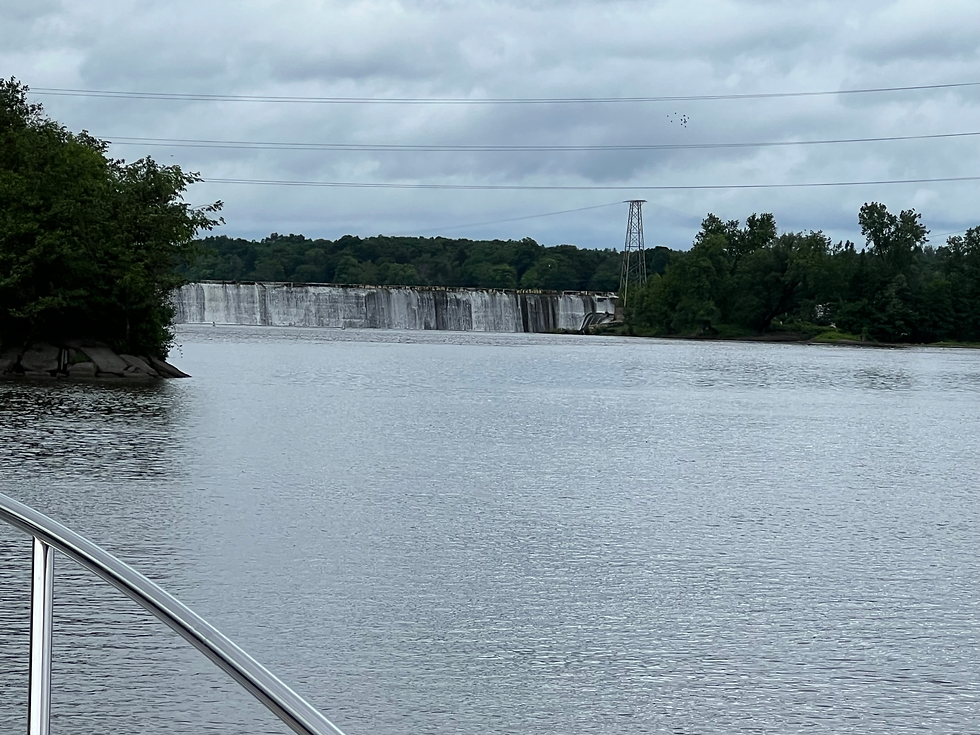Yesterday, Brio climbed a small hill. There is an excellent cruising guide available through Skipper Bob Publications for the New York Canal System. We include some of the drawings from the 2022 edition. They describe what we have done nicely. And there's more! But, as you can see, we have accomplished about half of the climb to the top of the Canal.
Here is a cross-section of the Canal, starting in Waterford, NY, just north of Troy. It shows the rise in the Canal to Rome to the west. Yesterday we covered the distance from Waterford to Amsterdam. That's ten locks of "work" by Brio, rising 255 feet above Waterford.

The Canal has been through three major renovations, starting in 1817 at Rome, NY under Governor Clinton's direction. By digging both east and west with picks and shovels, the Canal reached Amsterdam by 1822. It was completed by 1825.

Of course, there were improvements, as you can see. The Canal was enlarged by 1862. By today, it has been "streamlined" if you will, and made even larger.
All the while, competition, first by railroad, then by highways, forced it to improve.
So, what does all this look like? Here's a photo of a boat headed eastward exiting a lock as we wait to enter to go west. The boat is roughly Brio's size.

Clearly, the lock's size is overwhelming the size of the boat.
To control the water flow of the river down hill, dams were constructed. The lakes that formed upstream of the dam provides the water to flood the lock and cause boats to rise if they are heading upstream. Conversely, once the water level in the lock has risen, a boat can enter the upstream end of the lock, let the gates close and wait for the water in the lock to flow out of the lock downstream. That lowers the boat to the next level down hill.

Here we are waiting behind another boat to enter the Federal Lock at Troy.

Here we are, having entered the lock right behind our leader. The Troy Lock lift is only a 16-foot lift, so it is a good introduction to what will come.

Below, we hold on to the left (port) side of the lock walls. Here there is a vertical cable and we run a dock line behind the cable, letting it slide up the cable as Brio rises.. We wait for the upstream lock doors to swing open so we can then proceed upstream. As the lock fills with water, water is "boiling" and bubbling up all around us, causing Brio to move around. It requires constant adjusting to keep us in place next to the wall.

Let's look at what this looks like in a larger lock with a greater lift. Here we wait for the lock chamber to empty of water. You can see the water boiling up at the foot of the downstream lock gate.

Now we have a green light to enter the lock.

The "waterfall" at the head of the lock is upstream water leaking through the upstream gates. The water spills over the threshold of the upstream end of the lock. You can see the lock walls, covered with slime. Best to have rubber gloves!
All communication with the lock tender is by VHF Channel 13 ... and by friendly waves.

Here are the not-so-friendly lock walls with the vertical cables and also the ropes hanging down the walls that you can hold and keep yourself in one position as the lock fills with a cauldron-like water surface. You can see the top of the flagpole.

And here's that same flag pole once Brio has risen to the next level, some 35 feet above where she started at this lock.

Here are at the bottom of the lift, waiting as the boat begins to rise. Note the rubber gloves!


And here are the lock gates signing closed for our "lift."
The gates open once the lock is full and we are off to the next lock!

This is what we did for the Federal Lock at Troy and then the first ten locks of the Erie Canal yesterday.
We spent last night at Amsterdam and our next blog will show you just how beautiful the Canal is, surrounded by green.
Cheers,
Brio


Comentarios